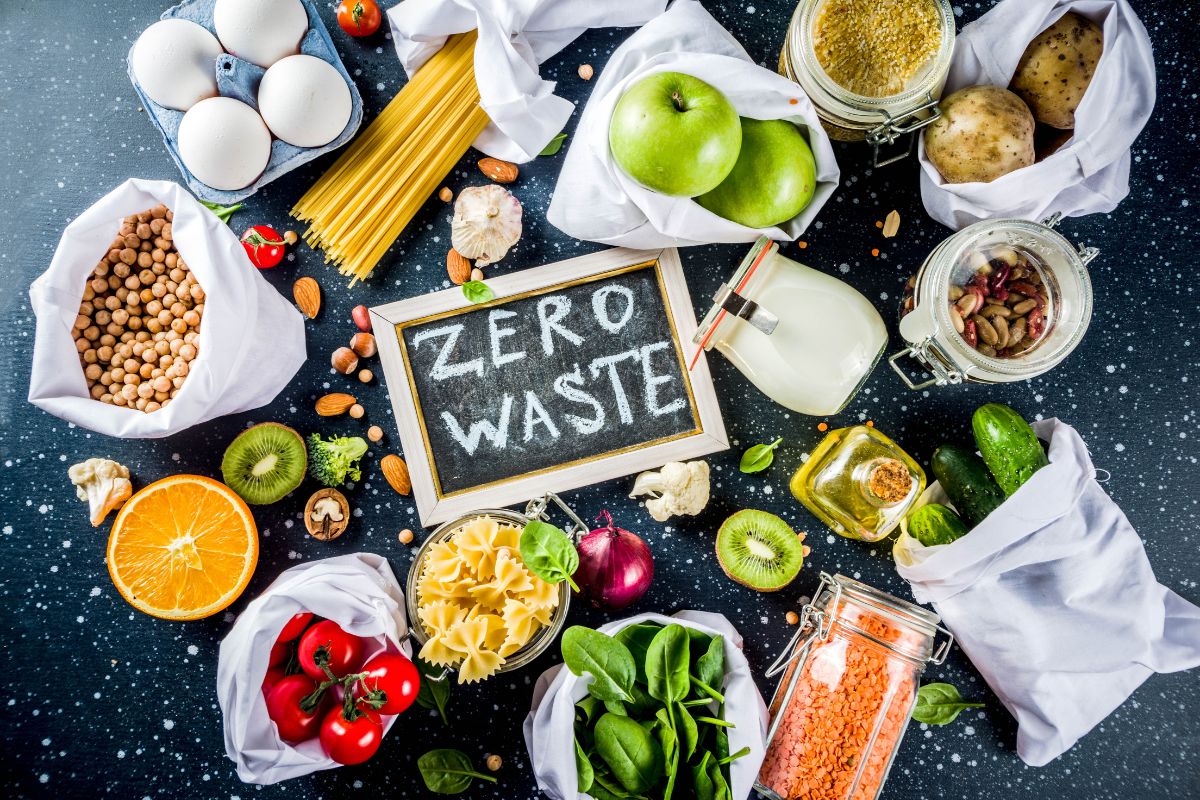Living zero waste means aiming to send little or no trash to landfill. In the US, each person generates about 4.5 pounds of waste per day, so even small cuts can add up. The zero-waste movement focuses on reusing, composting and refusing single-use items – a journey that “may save you some cash and give you a host of new skills”. Here are practical tips by area to help everyone from beginners to seasoned zero-wasters reduce waste at home.
Kitchen
Packaging accounts for roughly 30% of household garbage, so reducing food and container waste is key. Start by buying in bulk – bring your own jars or cloth bags to stock up on grains, beans, nuts and spices, cutting out tons of single-use packaging. Keep reusable produce bags on hand for fruits and veggies. Swap plastic wrap for beeswax cloths or silicone lids, and use glass or stainless containers for leftovers.
-
Beginner: Shop the bulk aisle with reusable containers (or mason jars) instead of packaged goods. Use cloth towels or sponges instead of disposable paper towels.
-
Beginner: Start a small compost pile or Bokashi bin to turn food scraps into soil, even in an apartment. Plan meals around leftovers so food doesn’t spoil.
-
Advanced: Make more food from “waste” parts – e.g. carrot-top pesto, homemade broth from veggie scraps or milk from oats/nuts at home. Try fermenting or canning excess fruits and veggies.
-
Advanced: DIY pantry staples: blend your own plant-based milks, sauces or dressings to eliminate cartons and bottles. Minimize cleaning product packaging by mixing multi-purpose cleaners from vinegar, baking soda and essential oils.
Bathroom
The bathroom often has many plastic-packaged items. A simple swap – like a bamboo toothbrush instead of plastic – eliminates waste because bamboo toothbrushes are compostable. Switch from bottled shampoo and soap to solid bars (shampoo bars, bar soap) in reusable tins. Choose a metal safety razor instead of disposables, and try refillable or mineral deodorant sticks. Use reusable cotton rounds or washcloths for makeup removal.
-
Beginner: Replace plastic disposables with reusable versions. For example, use a bamboo toothbrush and refillable bar shampoo/soap. Swap single-use cotton pads for washable cloth rounds.
-
Beginner: Reduce packaging by buying products in bulk or in refillable containers – many stores now fill your own bottles with lotions, creams, and shampoos.
-
Advanced: Make your own toothpaste (using baking soda and bulk ingredients) and natural beauty products (aloe vera gel, coconut oil, essential oils). Try a menstrual cup or cloth pads to avoid plastic pads and applicators.
-
Advanced: Reuse items fully – use every last bit of toothpaste or soap, compost toothbrush handles (bamboo or wooden), and recycle or repurpose glass and metal containers.
Cleaning
Swap out commercial cleaners for DIY, eco-friendly cleaners. A vinegar-water spray with a bit of lemon or tea tree oil cleans most surfaces and comes in a reusable bottle. Baking soda scrub plus vinegar rinse works wonders on tubs and sinks. Use washable microfiber cloths or old cotton rags instead of paper towels or disposable wipes.
-
Beginner: Clean with simple ingredients: white vinegar, baking soda and castile soap handle most jobs. Store them in repurposed glass spray bottles.
-
Beginner: Keep a kit of reusable cleaning tools (stainless steel scrubbers, bamboo scrubbing brushes, wool mop heads). Use one cleaner for multiple tasks (multi-purpose cleaner) to reduce bottles.
-
Advanced: Make homemade cleaners from kitchen scraps (e.g. soak citrus peels in vinegar for a week to create an all-purpose citrus cleaner). Use concentrated refill stations or make bulk concentrates to cut packaging.
-
Advanced: Use a “toilet bowl tab” from baking soda + borax instead of plastic-wrapped cleaners. Choose a bamboo toilet brush (lasts years), and opt for biodegradable soap bars (or refillable pods) for scrubbing.
Laundry
Reducing laundry waste saves time and detergent. Wash only full loads, and line-dry clothes whenever possible to save energy. One less wash by re-wearing (jeans, sweaters) means using less soap.
-
Beginner: Use detergent in bulk (powder or refill pouches) or try gentle DIY laundry soap. Skip dryer sheets by adding ½ cup white vinegar to the rinse cycle as natural softener. Hang clothes on a line or rack to dry.
-
Advanced: Switch to soap nuts or soapberries – a natural fruit that cleans laundry without plastic bottles. Use wool dryer balls instead of disposable sheets to reduce static. Wash in cold water when you can.
-
Advanced: Mend clothing and use natural fibers. Line-dry bedding and towels to save power. Make stain removers from baking soda or castile soap paste.
Daily Habits
Many zero-waste changes happen outside specific rooms, in everyday habits:
-
Carry Reusables: Always bring a reusable water bottle, coffee mug and utensils. Avoid buying bottled drinks or using plastic cutlery on the go. Keep cloth produce bags and totes in your car or purse for unplanned shopping.
-
Mindful Shopping: Plan meals and make lists to avoid impulse buys. Shop second-hand for clothes, toys or tools – thrift stores and swaps give items a long life. Say no to freebies (plastic straws, promo trinkets, single-use coffee cups) and pack your own.
-
Reduce Paper: Go digital where possible – e-bills, online tickets, or a note app instead of sticky notes – to cut paper clutter. Use cloth napkins instead of paper. Repair or repurpose items before throwing them away.
-
Zero-Waste Extras: Compost all food scraps (or join a community compost program) to cut trash. Grow some herbs or veggies to reduce packaging even more. Learn simple DIY skills (sewing a button, fixing a leak) – it saves waste and money.
Conclusion
Every zero-waste journey starts small. You don’t need to overhaul your life overnight – swapping just one habit or item each week still makes a difference. Remember that zero waste is a journey, not a destination. Even one reusable bag or one compost bin at a time adds up. Plus, many swaps pay off: buying in bulk often saves money and sparks fun DIY projects. Celebrate each step toward less waste, and encourage others by example. Consistent, small changes in your kitchen, bathroom, cleaning routines and daily habits will lead to a more sustainable home and a healthier planet.









